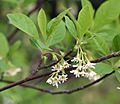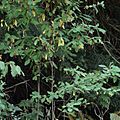Oemleria facts for kids
Quick facts for kids Oemleria |
|
|---|---|
 |
|
| Scientific classification | |
| Genus: |
Oemleria
|
| Species: |
cerasiformis
|
| Synonyms | |
|
|
Oemleria cerasiformis, often called osoberry or Indian plum, is a type of shrub. It is the only species in its group, known as the Oemleria genus.
This plant grows naturally along the Pacific coast of North America. You can find it from British Columbia, Canada all the way down to Santa Barbara County, California, U.S.A.. It is one of the first plants to grow new leaves and flowers very early in the spring. Osoberry shrubs usually grow to be about 1.5 to 5 meters (5 to 16 feet) tall. Their leaves are shaped like a spear and are 5 to 12 centimeters (2 to 5 inches) long.
The fruits of the osoberry are safe to eat. They look like small plums and turn a dark blue color when they are ripe. Native American groups have included osoberry in their food for a long time. They also make tea from the bark and chew the twigs. Chewing the twigs can act as a mild pain reliever.
Contents
Description
Osoberry is an upright, somewhat spread-out shrub. It can grow up to about 4.5 meters (15 feet) tall. Its leaves grow one after another along the stem. They are simple and fall off in the autumn. The leaves are usually oval or oblong, about 5 to 13 centimeters (2 to 5 inches) long. They are light green and smooth on top, and paler underneath with tiny soft hairs. Fresh osoberry leaves might smell and taste a bit like cucumber. This plant is one of the first to show new leaves in the spring.
Osoberry plants have separate male and female flowers. This means that male flowers grow on one plant, and female flowers grow on a different plant. The flowers have five petals and are white or greenish-white. They hang down and are about 1 centimeter (0.4 inches) wide. You can often see them in late winter, even before the leaves fully appear.
The fruits are bitter at first. They are oval-shaped and can be up to 1.3 centimeters (0.5 inches) long. They start out orange or yellow and turn blue-black when they are ripe. These fruits grow on a red stem. The twigs are thin and green, later turning reddish-brown. They have noticeable orange spots called lenticels. The bark of the plant is smooth and can be reddish-brown to dark gray.
Indian plum often grows like a bush, with many stems and branches spreading out. Branches that touch the ground can easily grow roots and become new plants. This means that a large osoberry plant is often surrounded by its own genetic copies.
Uses
The wood from the osoberry plant is very strong and has a fine grain. The stems are usually less than 5 centimeters (2 inches) thick. This small size means the wood can only be used for smaller items. However, the straight shoots are great for making simple arrows. If a stem is large and straight enough, it can even be made into an excellent self bow. The wood is also good for small wooden tools. These can include spoons, combs, or knitting needles. Because it has a fine grain and no strong patterns, the wood is also good for detailed carving.
Native American tribes along the Pacific coast used the osoberry's fruit, twigs, and bark. They used them for food, teas, and medicine. It is one of the first fruits from a tree to ripen in the summer. Because of this, it was highly valued by both Indigenous peoples and wild animals. How much fruit a plant produces can vary a lot. Plants in sunny spots usually grow more fruit, and the fruits are often larger and sweeter. The fruits can be eaten raw, or cooked if they are too bitter. They can sometimes make your mouth feel a bit dry or puckered.
Images for kids
-
An Indian plum shrub as its leaves begin to yellow in mid-summer, Pierce County, Washington
See also
 In Spanish: Oemleria cerasiformis para niños
In Spanish: Oemleria cerasiformis para niños




